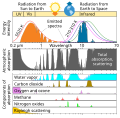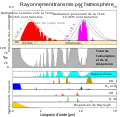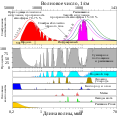File:Atmospheric Transmission.svg
外觀

此 SVG 檔案的 PNG 預覽的大小:614 × 600 像素。 其他解析度:246 × 240 像素 | 491 × 480 像素 | 786 × 768 像素 | 1,048 × 1,024 像素 | 2,096 × 2,048 像素 | 741 × 724 像素。
原始檔案 (SVG 檔案,表面大小:741 × 724 像素,檔案大小:321 KB)
檔案歷史
點選日期/時間以檢視該時間的檔案版本。
| 日期/時間 | 縮圖 | 尺寸 | 用戶 | 備註 | |
|---|---|---|---|---|---|
| 目前 | 2023年4月18日 (二) 16:19 |  | 741 × 724(321 KB) | Efbrazil | Adding white background color so renders correctly on smartphone |
| 2022年8月7日 (日) 20:29 |  | 741 × 724(321 KB) | Efbrazil | color bug fix | |
| 2022年8月7日 (日) 20:00 |  | 741 × 724(321 KB) | Efbrazil | Fixed translations as best as possible using text editor for new layout | |
| 2022年8月7日 (日) 19:34 |  | 741 × 724(320 KB) | Efbrazil | Fixing text alignment | |
| 2022年8月7日 (日) 19:26 |  | 741 × 724(320 KB) | Efbrazil | Graphical improvements as per discussion page | |
| 2022年2月17日 (四) 17:59 |  | 741 × 724(208 KB) | Pierre cb | File uploaded using svgtranslate tool (https://svgtranslate.toolforge.org/). Added translation for fr. | |
| 2021年3月18日 (四) 22:10 |  | 741 × 724(180 KB) | Cepheiden | german labels adjusted | |
| 2021年3月18日 (四) 22:09 |  | 741 × 724(180 KB) | Cepheiden | correction of labels | |
| 2021年3月18日 (四) 22:06 |  | 741 × 724(180 KB) | Cepheiden | File uploaded using svgtranslate tool (https://svgtranslate.toolforge.org/). Added translation for de. | |
| 2021年3月18日 (四) 21:52 |  | 741 × 724(154 KB) | Cepheiden | =={{int:filedesc}}== {{Information |description= {{en|1=This figure shows the absorption bands in the Earth's atmosphere (middle panel) and the effect that this has on both solar radiation and upgoing thermal radiation (top panel). Individual absorption spectrum for major greenhouse gases plus Rayleigh scattering are shown in the lower panel.}} |date=2021-03-18 |source=This figure was prepared by Robert A. Rohde for the Global Warming Art project. |author=[[User:Д.Ил... |
檔案用途
下列頁面有用到此檔案:
全域檔案使用狀況
以下其他 wiki 使用了這個檔案:
- ar.wikipedia.org 的使用狀況
- de.wikipedia.org 的使用狀況
- el.wikipedia.org 的使用狀況
- en.wikipedia.org 的使用狀況
- fr.wikipedia.org 的使用狀況
- gl.wikipedia.org 的使用狀況
- ha.wikipedia.org 的使用狀況
- ig.wikipedia.org 的使用狀況
- pt.wikipedia.org 的使用狀況
- simple.wikipedia.org 的使用狀況











